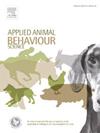环境的富集是否会影响胡须龙的行为和福利?
IF 2
2区 农林科学
Q1 AGRICULTURE, DAIRY & ANIMAL SCIENCE
引用次数: 0
摘要
环境富集已被证明是提高圈养动物福利的有效途径。虽然许多研究调查了富集对哺乳动物和鸟类物种的影响,但对爬行动物的富集知之甚少。爬行动物现在经常被当作宠物饲养,其中胡须龙(Pogona vitticeps)是最受欢迎的物种之一,因此了解住房条件如何影响它们的福利非常重要。在当前的研究中,我们调查了不同的居住条件(标准与两种类型的强化围栏:非自然主义和自然主义)对胡子龙(Pogona vitticeps)行为和福利的影响。蜥蜴(n = 12)在每种条件下被安置四周(平衡秩序),并在整个过程中进行行为观察。在四周结束时,他们的情感状态也通过焦虑测试(新环境和新对象测试)进行评估。在经历了所有的居住条件后,蜥蜴接受了三次成对偏好测试,它们可以在不同的围栏之间做出选择。与标准圈养区相比,生活在强化圈养区的胡须龙表现出明显更高的活动水平,运动增加,晒太阳和休息减少。此外,住在标准住房中的人会做出更多与压力相关的行为(例如,与玻璃屏障互动和舌头接触)。在焦虑测试中,来自强化围栏的动物表现出更大的信心,更频繁地接近新物体,并显示出在竞技场内部花费更多时间的趋势,同时也表现出更少的舌头接触行为。偏好测试进一步揭示了丰富的明显偏好比标准的围栏,和自然的比非自然的丰富围栏。这些发现表明,提供丰富的环境可以增加与良好福利相关的行为,同时减少与压力相关的行为,这是动物自己的首选。因此,为了提高圈养爬行动物的福利,在丰富的环境中饲养爬行动物是重要的。本文章由计算机程序翻译,如有差异,请以英文原文为准。
Does environmental enrichment impact the behaviour and welfare of bearded dragons (Pogona vitticeps)?
Environmental enrichment has been shown to be an effective way to improve the welfare of captive animals. Although many studies have investigated the effects of enrichment on mammalian and avian species, there is comparatively little known about this in reptiles. Reptiles are now frequently kept as pets, with bearded dragons (Pogona vitticeps) being one of the most popular species – it is therefore important to understand how housing conditions impact their welfare. In the current study we investigated the effect of different housing conditions (Standard vs. two types of Enriched enclosure: Non-naturalistic and Naturalistic) on the behaviour and welfare of bearded dragons (Pogona vitticeps). The lizards (n = 12) were housed in each condition for a period of four weeks (balanced for order), with behavioural observations conducted throughout. Their affective state was also assessed using anxiety tests (novel environment and novel object tests) at the end of the four weeks. After experiencing all of the housing conditions, the lizards were given three pairwise preference tests where they could choose between the different enclosures. Bearded dragons housed in Enriched enclosure exhibited significantly higher activity levels, with increased movement and reduced basking and resting compared to those in the Standard enclosure. Additionally, individuals in Standard housing engaged in more behaviours associated with stress (e.g. interaction with a glass barrier and tongue touching). In the anxiety tests, animals from Enriched enclosures displayed greater confidence, approaching novel objects more frequently and showed a trend towards spending more time in the arena’s inner section, while also exhibiting fewer tongue-touch behaviours. Preference tests further revealed a significant preference for Enriched over Standard enclosures, and for the Naturalistic over the Non-naturalistic enriched enclosure. These findings suggest that providing environmental enrichment increases behaviours linked with good welfare while reducing those associated with stress and is preferred by the animals themselves. Housing reptiles in enriched environments is therefore important in order to enhance their welfare in captivity.
求助全文
通过发布文献求助,成功后即可免费获取论文全文。
去求助
来源期刊

Applied Animal Behaviour Science
农林科学-行为科学
CiteScore
4.40
自引率
21.70%
发文量
191
审稿时长
18.1 weeks
期刊介绍:
This journal publishes relevant information on the behaviour of domesticated and utilized animals.
Topics covered include:
-Behaviour of farm, zoo and laboratory animals in relation to animal management and welfare
-Behaviour of companion animals in relation to behavioural problems, for example, in relation to the training of dogs for different purposes, in relation to behavioural problems
-Studies of the behaviour of wild animals when these studies are relevant from an applied perspective, for example in relation to wildlife management, pest management or nature conservation
-Methodological studies within relevant fields
The principal subjects are farm, companion and laboratory animals, including, of course, poultry. The journal also deals with the following animal subjects:
-Those involved in any farming system, e.g. deer, rabbits and fur-bearing animals
-Those in ANY form of confinement, e.g. zoos, safari parks and other forms of display
-Feral animals, and any animal species which impinge on farming operations, e.g. as causes of loss or damage
-Species used for hunting, recreation etc. may also be considered as acceptable subjects in some instances
-Laboratory animals, if the material relates to their behavioural requirements
 求助内容:
求助内容: 应助结果提醒方式:
应助结果提醒方式:


